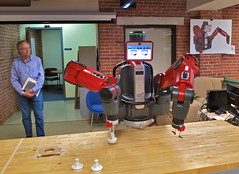By Billy Aldridge
Being a plumber means getting
to thrill vicariously at all the DIY shows on TV. Sure, watching guys like Norm Abram go
through the paces of rebuilding this or that old home is always an
inspiration. While the DIY show genre
was almost single-handedly inspired by Norm’s predecessor and mentor, Bob Villa,
every single DIY spinoff is hosted by a dyed-in-the-wool professional with
years of on the job experience. So if I
was going to throw my hat into the ring to create a DIY plumbing show that
showed it like it is, I wouldn’t spin it as a “Fix this Plumbing” concept at
all. No, I think a more informative and vastly more entertaining angle would be
to create a series that showcases the unfortunate results of people who thought
they could save some money by doing it themselves. I call the concept “Down the Drain DIY.” Here
is an episode that I have cobbled together from doing a little research online.
Episode 1: The Hosed
Housewife (Or, how to turn a $10 DIY into a $360 emergency plumbing repair.)
Our upstairs hall toilet sprung a leak recently, emitting a
steady hiss punctuated by frequent whooshes of the pump refilling the tank -- a
bit like having Darth Vader lurking in the hall. We don't use it much, so I
just turned off the water to the toilet and silenced the evil Jedi. But with
visitors arriving shortly from the UK, it occurred to me that access to a loo
that didn't involve traipsing through our bedroom might be preferred by all
parties.
I was ready to call a plumber, but my dad scoffed on the phone. "An
easy fix. Just needs a new fill valve," he assured me. So off I went to
Home Depot where yes indeed, Mr. Orange Apron fixed me up with a replacement
fill valve for about $10. (something my dad continues to call a 'ball cock'
even though they no longer have balls and don't cock. It's been replaced by
something that's more like a 'shank donut' but honestly, that doesn't sound any
less dirty.) The Force was strong in me. I imagined my light saber emerging
from the end of the fill valve and beheading a plumber. Take that!
Once back from her trip to
the big box store, our heroine realized that the instructions that came with
the parts were less than adequate.
Undaunted, she pressed on and completed the repair to the best of her
ability. Then she opened the shutoff
valve.
I turned on the water... and a steady stream cascaded onto
the floor. I turned off the water. I
could still hear a little hiss, like it wasn't all the way off, but it looked
like it was off. I turned the handle a little harder. No change. Harder. The
water started coming out of the hose faster. I turned it the other way. No
change. Turned it back. The stream became a torrent.
Suddenly, a fill
valve was the least of my problems. I had no idea where the main water cutoff
for the house was. I emptied the linen closet onto the floor, ran to the phone
and called the first plumber in the yellow pages that said 24×7 emergency
service, grabbed a couple of bowls and raced back upstairs. Where I sat for
over an hour, bailing water
into the tub at the rate of one bowl every 30 seconds or so. I believe that
counts as a workout.
The moral of the story is you
need to know how and where to shut off the water to your home if you don’t want
to wind up getting hosed. (Below is a video that shows you step-by-step how to
locate and turn off the water main.)
While do-it-yourself is all
the rage, the bottom line for many homeowners is that unless you know your
limits, you need to have a fallback plan in place and you absolutely need to
have your friendly neighborhood plumber’s phone number on speed dial the next
time you get the urge to DIY.
Billy Aldridge is one of the
Doctors of Plumbology at Aldridge and sons Plumbing in Jacksonville,
Florida. For more helpful plumbing tips
and step-by-step DIY videos, go to http://plumbers-jacksonville-fl.com






